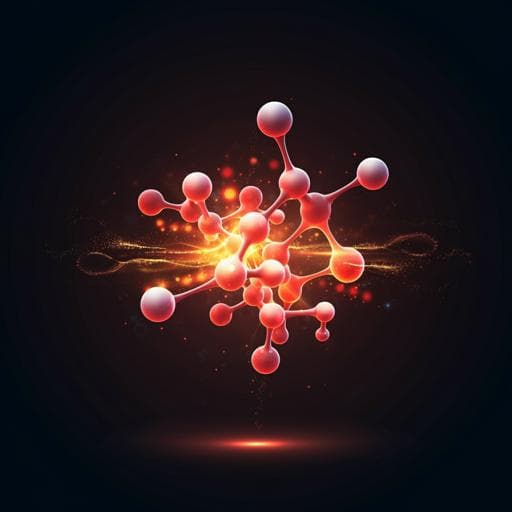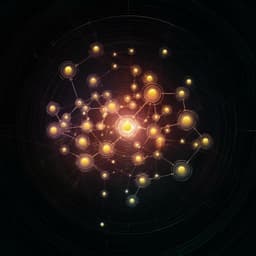
Chemistry
Streamlining the synthesis of amides using Nickel-based nanocatalysts
J. Gao, R. Ma, et al.
Explore a groundbreaking method for amide synthesis that leverages the reductive amidation of esters with nitro compounds without additives. This innovative approach, developed by Jie Gao, Rui Ma, Fairoosa Poovan, and others, showcases the selective preparation of diverse amides, making it a game-changer for drug synthesis and biocompound modifications.
~3 min • Beginner • English
Introduction
Amide bond formation is ubiquitous across pharmaceuticals, biomolecules, and materials, but classic routes rely on activated carboxylic acid derivatives or stoichiometric coupling agents (e.g., DCC, EDC, HATU, thionyl chloride), leading to waste, cost, and purification challenges. Addressing the ACS Green Chemistry Institute challenge to avoid poor atom economy reagents, the authors target more sustainable amidation. Esters are attractive electrophiles for amidation, and nitroarenes are step-economical amine precursors. Prior direct amidations using nitroarenes required homogeneous catalysts with stoichiometric reductants or expensive hydrosilanes, and no heterogeneous systems using H2 were available. The study proposes a heterogeneous Ni-based nanocatalyst on TiO2 enabling reductive amidation of esters with nitro compounds under H2 without additives, aiming for broad scope, chemoselectivity, scalability, and mechanistic understanding of active sites.
Literature Review
Traditional amide syntheses commonly couple carboxylic acids (or activated derivatives like acyl chlorides/anhydrides) with amines using stoichiometric coupling/activating agents, causing substantial waste and cost (Refs. 2, 10–15). Advances include catalytic direct amidation of unactivated acids with amines (e.g., zirconium catalysis; Ref. 22) and cross-coupling approaches using esters (Refs. 7, 16–18). Direct amidation employing nitroarenes as amine surrogates is attractive but has relied on homogeneous systems, such as Ni catalysts with stoichiometric Zn/TMSCl or Ir–Fe photocatalysis with PhSiH3 (Refs. 19–21), limiting practicality and sustainability. Heterogeneous catalysts using molecular hydrogen for the cascade hydrogenation–amidation were unexplored. Prior work from the authors developed nanostructured 3d-metal catalysts on oxides and carbon supports for redox transformations (Refs. 25–39), motivating exploration of TiO2-supported Ni nanoparticles for ester valorization and amidation.
Methodology
Catalyst synthesis: Ni, Co, and Fe nanoparticles were prepared on supports (TiO2, γ-Al2O3, SiO2, Vulcan carbon) using aniline-derived ligands (L1 o-phenylenediamine, L2 p-phenylenediamine, L3 aniline). Metal nitrates and ligand were mixed in methanol, immobilized on the support, solvent removed, and the solid pyrolyzed under Ar at 400–1000 °C. Materials are denoted M-L@Support-T. The optimal catalyst, Ni-L1@TiO2-800, used TiO2 prepared via sulfate process and pyrolyzed at 800 °C.
Catalyst evaluation: Benchmark reductive amidation converted 4-nitrophenol and ethyl acetate to paracetamol under 20 bar H2, 130 °C, 24 h, solvent-free. Various M/supports and ligands were screened (Table 1). Reaction design avoided additives and external solvents; transfer hydrogenation using formic acid (FA) and CO/H2O (water–gas shift conditions) were also tested to probe robustness.
Recycling: The optimal catalyst was recycled in consecutive runs under standard conditions. Post-reaction, the catalyst was separated by centrifugation, washed with ethyl acetate, dried, and reused without reactivation. ICP-OES checked Ni leaching.
Characterization: TEM/HAADF-STEM with EDS mapping assessed particle size and dispersion. XRD identified phases (metallic Ni, Ni3S2, TiO2 phases). XPS (including in situ under N2 and H2 at 130 °C) probed Ni and Ti oxidation states. BET measured surface area. NH3-TPD and CO2-TPD quantified acid/base sites. Additional controls included hydrogenation of 4-nitrophenol to 4-aminophenol and amidation of 4-aminophenol with ethyl acetate to deconvolute steps.
Mechanistic studies: Kinetic profiling tracked conversion of 4-nitrophenol to 4-aminophenol (hydrogenation) and subsequent amide formation. In situ XPS under H2 vs N2 compared formation of metallic Ni and low-valent Ti species (Ti3+/Ti2+). DFT computations examined adsorption of aniline on anatase TiO2 (101) at Ti4+ vs Ti3+ sites, evaluating adsorption energies and N–H activation.
Scope and scalability: Standard conditions for scope used 30 mg Ni-L1@TiO2-800, 20 mg TiO2, 0.5 mmol nitro compound, 1 mL ester, 20 bar H2, 130 °C, 24 h. Alternative solvent (toluene) and substrate ratios (nitro:ester 1:4) were explored. Substrate classes included diverse nitroarenes (electron-rich/-poor, halogenated, aliphatic, heterocycles) and various alkyl/aryl esters (including fluorinated and diesters). Late-stage modifications of bioactive molecules and drug synthesis were demonstrated. Scale-up reactions were performed at 1.2 g and 10 g scales.
Key Findings
- Optimal catalyst: Ni-L1@TiO2-800 outperformed other metals/supports. In solvent-free reductive amidation of 4-nitrophenol with ethyl acetate (20 bar H2, 130 °C, 24 h), it gave paracetamol in 85% yield with >99% conversion (Table 1, entry 4). Co-L1@TiO2-800 afforded 53% yield; Fe-L1@TiO2-800 showed low activity (12% yield at 17% conversion).
- Support/ligand effects: Carbon-supported Ni favored hydrogenation only (97% 4-aminophenol, <1% amide). Materials without ligand or non-pyrolyzed were inactive. Pyrolysis temperature had a strong influence; 800 °C was optimal.
- Alternative reductants/conditions: With CO/H2O (WGS conditions), paracetamol formed in 88% yield; with formic acid, 52% paracetamol plus 48% N-formylation byproduct.
- Stability and recyclability: Catalyst retained activity for 7 cycles; after the 8th run activity decreased, attributed to Ni nanoparticle growth from 11.7 nm to 24.2 nm (TEM). ICP-OES detected no significant Ni leaching (detection limit 0.03 wt%).
- Structure–activity insights: XRD showed metallic Ni peaks for catalysts pyrolyzed at ≥800 °C; sulfur from the TiO2 sulfate process led to Ni3S2 signatures, yet commercial Ni3S2 alone was inactive, indicating a synergistic material. XPS revealed increasing surface Ni0 fraction with higher pyrolysis, peaking at ~43% for Ni-L1@TiO2-800. NH3-TPD showed more weak acid sites for Ni-L1@TiO2-800 vs Ni-L1@TiO2-600, correlating with higher amidation activity (47% vs 34% paracetamol from 4-aminophenol + ethyl acetate).
- Mechanism: Kinetics indicated rapid nitro reduction (to 4-aminophenol in ~4 h) and slower amidation (>20 h). In situ XPS under H2 at 130 °C showed reduction of Ni2+ to Ni0 and emergence of Ti3+/Ti2+ on TiO2 (more pronounced for Ni-L1@TiO2-800 than Co-L1@TiO2-800); under N2, Ti remained Ti4+. DFT showed stronger adsorption of aniline on Ti3+ (Eads −1.153 eV) than Ti4+ (−0.959 eV) and greater N–H bond elongation on Ti3+, supporting activation at low-valent Ti sites.
- Substrate scope: Broad functional group tolerance. Nitroarenes with electron-donating/withdrawing groups afforded amides in up to 89% isolated yield; halides retained; aliphatic nitro compounds gave 67–72% yields. Ketones, acids/esters, nitriles, vinyls, and heterocycles were tolerated (many 60–78% yields; a vinyl substrate gave 32%). Various alkyl/aryl esters, including fluorinated and diesters, worked; diesters gave mono-amides selectively; diamide accessible from 4-nitroaniline.
- Practicality: Optimized nitro:ester ratio 1:4 in toluene improved outcomes across test substrates. Drug syntheses: Acedoben 68%, Actarit 72%, Phenacetin 94%, Propanil 89%. Late-stage modifications: MCPA-methylester to amide 56%; rhodamine probe 69%; nimesulide 75%; nimodipine 72%; others 70–77%. Scale-up delivered paracetamol 87% (10 g) and propanil 82% (10 g); a further example gave 64% at 1.2 g scale.
Discussion
The study addresses the challenge of sustainable amide bond formation by enabling a one-pot, additive-free reductive amidation of esters with nitro compounds using H2 and a heterogeneous Ni/TiO2 nanocatalyst. The observed kinetics and controls confirm a tandem mechanism: rapid nitro reduction on metallic Ni followed by amidation facilitated by the TiO2 support. In situ XPS demonstrates that H2 activation over Ni generates low-valent Ti species (Ti3+/Ti2+) at the support surface, which correlate with enhanced amidation activity. DFT corroborates stronger, more activating interactions of aniline with Ti3+ vs Ti4+ sites, rationalizing rate enhancement and chemoselectivity. The dependence on pyrolysis temperature links the formation of metallic Ni and optimal surface acidity to performance, while the role of TiO2 acidity and surface area is further supported by TPD and standalone TiO2 tests. Broad scope, high chemoselectivity (e.g., halide retention), late-stage functionalization, and gram-to-deca-gram scalability underscore the method’s practical relevance for fine chemicals and pharmaceuticals. Overall, the results validate the hypothesis that synergistic Ni0–TiOx− (low-valent Ti) interfaces enable the desired cascade under green reductants, advancing heterogeneous, step-economical amide synthesis.
Conclusion
A heterogeneous Ni-L1@TiO2-800 catalyst enables direct, additive-free reductive amidation of esters with nitro compounds using molecular hydrogen. The method displays wide substrate scope, excellent chemoselectivity, and functional group tolerance, and it is scalable to multi-gram quantities. Mechanistic experiments and DFT identify metallic Ni (for nitro reduction) and low-valent Ti species (for amidation via aniline activation) as key contributors, with optimal performance at 800 °C pyrolysis where Ni0 fraction and weak acid sites are maximized. The protocol streamlines access to industrially relevant amides and drug molecules (e.g., paracetamol, phenacetin) and enables late-stage modifications of bioactive compounds. Future work could focus on improving catalyst longevity (mitigating nanoparticle aggregation), expanding to more challenging substrates, reducing H2 pressure/temperature, and engineering supports to tune Ti valence and acidity for further rate and selectivity enhancements.
Limitations
- Catalyst deactivation after seven recycling cycles due to Ni nanoparticle aggregation (growth from ~11.7 nm to ~24.2 nm), despite negligible Ni leaching.
- The amidation step is rate-limiting and requires elevated temperature (130 °C) and H2 pressure (20 bar) for optimal rates.
- Under formic acid transfer hydrogenation, competitive N-formylation limits amide yield (52% amide with 48% formylated byproduct in the model system).
- Performance depends on precise pyrolysis parameters and support properties; deviations (e.g., different temperatures or supports) reduce selectivity/activity.
- Certain substrates show modest yields (e.g., a vinyl-containing example at 32%), indicating scope limitations for highly sensitive functionalities.
Related Publications
Explore these studies to deepen your understanding of the subject.







